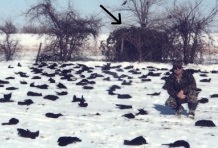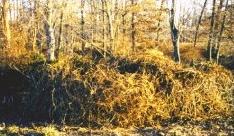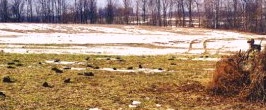 |
Advanced Blind Tactics
Techniques for constructing and hunting a successful crow hunting blind
When it comes to hunting crows from a stationary location, a well constructed blind is almost a necessity if you want to take large numbers of birds. Obviously, it is important to scout ahead of time for concentrations of crows or even flyways before deciding on a hunting location. Once a general location has been decided on, employing the tactics described below will greatly increase your chance for a successful hunt.
Think Ahead: As we know, crows are very observant. Constructing a blind in advance will allow the crows to become accustomed to it and will prevent any unnecessary commotion when it comes time to hunt.
Face the Enemy: It may seem obvious, but you should try to build the blind facing in the direction that you expect that the bulk of the crows will be coming from. It is hard enough to hit a diving crow without constantly having to swing around behind you. In the case of a flyway, construct the blind facing the morning or evening flight, depending on which you will normally hunt.
A Glaring Problem: Little details can sometimes play an important part in a successful hunt. If it's a morning hunt in a good feeding area, don't face the blind into the south east or you will be looking into the sun all morning! This can cause real problems with glare and consequently your shooting. If possible, face either to the south west or west, and keep your decoys out in front of the blind if the wind is from a northerly direction. In this way, the crows will not swing around the back side of the blind!

This successful blind was constructed in existing natural ground cover and allows a 180 degree field of fire.
Height Headaches: Look for a spot where the existing cover is not to tall! Crows tend to drop to the height of the surrounding vegetation and the ideal spot is where the cover doesn't exceed 45 feet in height! If you are hunting a setup that is mostly wooded, try to find a patch of low trees with an opening in the middle. This forces the crows over the open area to investigate the calling and within ideal shotgun range.
Hide & Seek: We all know that crows are masters at detecting something that is out of place. Try to pick a location that takes advantage of existing cover including hedge rows, low pines or even corn stalks and always try to construct your blind out of local vegetation. Commercial camouflage material can be used, but should be "sweetened" up with some natural foliage to create a 3D look and feel. Try to construct the blind so that it hides the hunters on all 4 sides and make every effort to keep the height of the blind level with the surrounding growth. Crows will notice a blind that looks anything like a duck blind on a marsh. Finally, backup and take a look at the blind from a distance, the same view the incoming birds would. If you have a hard time telling where the blind starts and stops, you are ready!

Field of Fire: Perhaps the biggest mistake beginners make is in failing to plan for sufficient shooting lanes when it comes to a crow setup. They have read so much about the supernatural ability of crows to detect a hunter, that they bury themselves deep in surrounding brush and can barely get their gun up much less swing on fast diving birds. All the camouflage in the world won't help if you can't get a decent shot, so plan accordingly and spend enough time locating a stand that gives a balance between concealment and shootability. If possible, try to construct your blind with at least a 180 degree angle of killing zone. Crows are notoriously unpredictable and will offer shots in all directions.

Range of Motion: Wing shooting requires the ability to lead and swing on a target, and crow hunting is no exception. In fact, crow shooting will test the skills of even the most experienced trap or skeet shooter. With this in mind, be sure to build a blind that allows for the proper range of motion necessary for shotgunning. Shooting out a "hole" in the blind at moving crows pretty much guarantees a low hit percentage. Also remember to make the walls of the blind low enough to allow for a standing shot. Your shotgun swing is reduced by 50% when sitting.
Burning Out: Overhunting a stationary blind will quickly wise up the local birds and your success will drop dramatically. Whenever possible, give a blind a rest of at least week or two after shooting. If you are limited to only a few hunting locations, try constructing more than one blind on the same property, even if it is simply on the other side of the field. By rotating blind usage, you can shorten the wait between hunts.

Specialty Blinds: There are many unconventional ways to construct blinds for hunting crows. You can use abandoned farm equipment, hay bales, corn stalks, marsh grass, an existing goose pit or even a ghillie suit. Regardless of the type of blind you use, remember to apply the tactics discussed above and you will maximize your success when hunting the black bandit.
Other Related Articles
The Ditch Blind
The Cedar Ball Permanent Blinds
The Portable Orchard Blind
Special thanks to Staff Advisor Bob Aronsohn for contributing to this subject. |
 |

 Advanced Techniques
Advanced Techniques